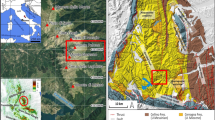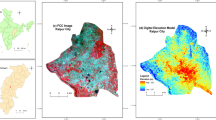Abstract
Glacier is a common sensitivity indicator of environmental and global climate change. Examining the relationship between glacier area and climate change will help reveal glacier change mechanisms and future trends. Glacier changes are also of great significance to the regulation of regional water resources. This study selected the Hala Lake Basin in the northeastern Qinhai-Tibet Plateau as a study area, and examined the relationships between the temporal and spatial change of glaciers in the northeastern Qinghai-Tibet Plateau and climate change based on remote sensing imagery, climatological data, and topographic data during the past 30 years. Results showed that glacier area in the Hala Lake basin fluctuated and decreased from 106.24 km2 in 1986 to 78.84 km2 in 2015, with a decreasing rate of 0.94 km2·yr−1. The number of glacier patches, mean patch area, and largest patch index all decreased from 1986 to 2015, while the splitting index increased from 1986 to 2015, indicating that the landscape fragmentation of glacier in the Hala Lake Basin was increasing significantly during the study period. Glacier area change was mainly concentrated in the slopes >25° with an altitude of 4500–5000 m, and the retreating rate of glacier of sunny slope was obviously higher than that of shady slope. Geometric center of glacier in the basin moved from southwest to northeast towards high altitude. Results of the response of glacier extent to climate change showed that temperature was the dominant factor affecting glacier area dynamic change in the Hala Lake Basin. It is predicted that in future several years, the glacier area will decrease and fragment continually as a result of global warming on the Tibetan Plateau.
Similar content being viewed by others
References
Barnett T, Adam J, Lettenmaier D, (2005) Potential impacts of a warming climate on water availability in snow-dominated regions. Nature 438(17): 303–309. https://doi.org/10.1038/nature04141
Cao J, Zhang J, Zhang C, et al. (2007) Environmental changes during the past 800 years recorded in lake sediments form Hala Lake on the northern Tibetan Plateau. Quaternary Sciences 27(1): 100–107. (In Chinese)
Charalampos C, Andrea F, Michael K, et al. (2018) Mass-budget anomalies and geometry signals of three Austrian glaciers. Frontiers in earth science 6: 218. https://doi.org/10.3389/feart.2018.00218
Cui B (2007) Landscape changes and drive forces analysis of typical region in KuBuQi Desert. LuDong University. (In Chinese)
Cui B, Li X, Jiang G, et al. (2011) Study on land use/cover in mountain area based on the DEM—Taking the Qinghai Lake basin as an example. Journal of Natural Resources 26(5): 871–880. (In Chinese)
Forman R, Godron M (1986) Landscape ecology. New York: Wiley & Sons.
Gerard H, Marcia B, Florian H (2017) Centennial glacier retreat as categorical evidence of regional climate change. Nature Geoscience 10: 95–99. https://doi.org/10.1038/ngeo2863
Guo L, Ye Q, Yao T, et al. (2007) The glacial landforms and the changes of glacier and lake area in the Mapam Yumco Basin in Tibetan Plateau based on GIS. Journal of Glaciology and Geocryology 29(4): 517–524. (In Chinese)
He Y, Yang T, Ji Q, et al. (2015) Glacier variation in response to climate change in Chinese Tianshan Mountains from 1989 to 2012. Journal of Mountain Science 12(5): 1189–1202. https://doi.org/10.1007/s11629-015-3445-6
Hua W, Fan G, Chen Q, et al. (2009) Study of interdecaday variation of the annual sunshine duration over Tibetan Plateau. Resources and Environment in the Yangtze Basin 18(12): 1149–1155. (In Chinese)
Ji D (2012) Climate change and its influence on NDVI over the Qinghai-Tibet Plateau. Nanjing University of Information Science. (In Chinese)
Ke L, Ding X, Li W, et al. (2017) Remote sensing of glacier change in the central Qinghai-Tibet Plateau and the relationship with changing climate. Remote Sensing 9(2): 114. https://doi.org/10.3390/rs9020114
Li C (2014) Remote sensing monitoring of glacier and snow cover changes in the Kunlun Mountain. Lanzhou University. (In Chinese)
Li C, Yang T, Tian H (2013) Variation of west Kunlun Mountains glacier during 1990–2011. Process in Geography 32(4): 549–559. (In Chinese)
Li H, (2013) Environmental evolution documented by Hala Lake sediments at the northern margin of Tibet Plateau since 4.3 kaBP. Lanzhou University. (In Chinese)
Li S, Cao G, Shi P (2014) Air temperature variation and mutation analysis of cold/warm season in Qinghai Lake watershed from 1970 to 2012. Journal of Qinghai Normal University (Natural Science) (3): 60–65. (In Chinese)
Li X (2015) Monitoring glacier change based on remote sensing in the Hengduan Mountains for the last four decades. Lanzhou University. (In Chinese)
Li Z (2012) Glaciers and lakes changes on the Qinghai-Tibet Plateau under climate change in the past 50 years. Journal of Natural Resources 27(8): 1431–1443. (In Chinese)
Li Z, Li H, Chen Y (2011a) Mechanisms and simulation of accelerated shrinkage of continental glaciers: A case study of Urumqi glacier No. 1 in eastern Tianshan, Central Asia. Journal of Earth Science 22(4): 423–430. https://doi.org/10.1007/s12583-011-0194-5
Li Z, He Y, Wang S, et al. (2009) Changes of some monsoonal temperate glaciers in Hengduan Mountains region during 1900–2007. Acta Geographica Sinica 64(11): 1319–1329. (In Chinese)
Li Z, He Y, An W (2011b) Climate and glacier change in southwestern China during the past several decades. Environmental Research Letters 6(4): 045404. https://doi.org/10.1088/1748-9326/6/4/045404
Liu Q, Liu S (2016) Response of glacier mass balance to climate change in the Tianshan Mountains during the second half of the twentieth century. Climate Dynamics 46(1–2): 301–316. https://doi.org/10.1007/s00382-015-2585-2
Liu S, Li J, Shangguan D, et al. (2006) Glaciers in response to recent climate warming in western China. Quaternary Sciences 26(5): 762–771. (In Chinese)
Liu S, Shangguan D, Ding Y, et al. (2005) Glacier variations since the early 20th century in the gangrigabu range, Southeast Tibetan Plateau. Journal of Glaciology and Geocryology 27(1): 55–63. (In Chinese)
Liu Z, Liu Z, Wang F (1962) Comparing the vicinity of Mount Everest, Tengri, Qilian unity Quaternary glacial peak of development. Acta Geographica Sinica 28(1): 19–33. (In Chinese)
Liu Z, Ju J (1959) Mountain glacier. Geographical Knowledge (1–12): 261–264. (In Chinese)
Lu Y, Wu A (1984) Natural situation and vegetation types of Lake Hala in Qinghai province. Grassland of China 02: 27–31. (In Chinese)
Ma J (2014) Climatic characteristics of Delingha city in recent 40 years. Qinghai Weather 1–5. (In Chinese)
Ma X, Chen D, Yang Y, et al. (2014) Statistical analysis of XRF scanned elements and their environmental significance in Hala Lake, Qinghai, China. Journal of Salt Lake Research 22(4): 1–10. (In Chinese)
Pu J, Yao T, Wang N, et al. (2004) Fluctuations of the glacier on the Qinghai-Tibetan Plateau during the past century. Journal of Glaciology and Geocryology 26(5): 517–522. (In Chinese)
Sakai A, Fujita K (2017) Contrasting glacier responses to recent climate change in high mountain Asia. Scientific Reports 7: 13717. https://doi.org/10.1038/s41598-017-14256-5
Shangguan D, Liu S, Ding Y, et al. (2004) Glacier changes at the head of Yurungkax River in the west Kunlun Mountains in the past 32 years. Acta Geographica Sinica 59(6): 855–862. (In Chinese)
Sun M, Liu S, Yao X, et al. (2015) Glacier changes in the Qilian Mountains in the past half century: Based on the revised First and Second Chinese Glacier Inventory. Acta Geographica Sinica 70(9): 1402–1414. (In Chinese)
Tian H, (2013) Glacier area changes in the Qilian Mountains, China. Lanzhou University. (In Chinese)
Tian H, Yang T, Lv H, et al. (2016) Climate change and glacier area variations in China during the past half century. Journal of Mountain Science 13(8): 1345–1357. https://doi.org/10.1007/s11629-015-3685-5
Twila M (2017) Saying goodbye to glaciers. Science, 356(6338): 580–581. https://doi.org/10.1126/science.aam9625
Wang K, Yang T, Shao W, et al. (2015) Remote sensing monitoring on glacier change in the middle of the Alps in Switzerland from 1984 to 2013. Research of Soil and Water Conservation 22(5): 300–305. (In Chinese)
Wu C, Tang D (2017) Change of temperature in the Tibetan Plateau in the context of global warming in recent 50 years. Research of Soil and Water Conservation 24(6): 262–272. (In Chinese)
Wu D (2016) Remote sensing analysis of the dynamic change of glacier on the Tibet Plateau. (Master thesis), China University of Geosciences. (In Chinese)
Wu G, Liu C (1979) Glacier effect characteristic and water resource utility problem in the drainage area of Hala Lake. Journal of Glaciology and Geocryology (2): 27–32. (In Chinese)
Wu H, Yang M, Yang C, et al. (2016) Effect of glacier mass loss on water level fluctuation of lake in Hala Lake basin. Journal of Water Resources & Water Engineering 27(4): 13–20. (In Chinese)
Xiang L, Wang H, Steffen H, et al. (2016) Groundwater storage changes in the Tibetan Plateau and adjacent areas revealed from GRACE satellite gravity data. Earth and Planetary Science Letters 449: 228–239. https://doi.org/10.1016/j.epsl.2016.06.002
Yan R, Guo S, An G, et al. (2015) Precipitation patterns during 1961–2013 in the area of southern Qinghai Lake. Chinese Agricultural Science Bulletin 31(22): 248–255. (In Chinese)
Yang X, Din W, Liu M, et al. (2011) Change characteristics of temperature in eastern Hexi Corridor in recent 50 years. Journal of Arid Land Resources and Environment 25(8): 76–81. (In Chinese)
Yang X, Ding W, Guo L (2010) Analysis on the basic characteristics of precipitation in the east Hexi Corridor. Arid Zone Research 27(5): 663–668. (In Chinese)
Yao H, Li D (2016) The interannual variation of wind speed in the Tibetan Plateau in spring and its response to global warming during 1971–2012. Acta Meteorologica Sinica 74(1): 60–75. (In Chinese)
Yao T, Pu J, Lu A (2007) Recent glacial retreat and its impact on hydrological processes on the Tibetan Plateau, China, and surrounding regions. Arctic Antarctic and Alpine Research 39(4): 642–650. https://doi.org/10.1657/1523-0430(07-510)[YAO]2.0.CO;2
Yao T, Wang Y, Liu S, et al. (2004) Recent glacial retreat in High Asia in China and its impact on water resource in northwest China. Science in China Series: D 47(12): 1065–1075. https://doi.org/10.1360/03yd0256
Ye Q, Cheng W, Zhao Y, et al. (2016) A review on the research of glacier changes on the Tibetan Plateau by remote sensing technologies. Journal of Geo-information Science 18(7): 920–930. (In Chinese)
Yin J, Xie Z, Wu L, et al. (2012) Characteristics of glacier distribution in Nepal Himalaya. Journal of Natural Science of Hunan Normal University 35(3): 78–83. (In Chinese)
Zhang G, Yao T, Shum C, et al. (2017) Lake volume and groundwater storage variations in Tibetan Plateau’s endorheic basin. Geophysical Research Letters 44(11): 5550–5560. https://doi.org/10.1002/2017GL073773
Zhao R, Ye Q, Zong J (2016) Glacier and water storage changes in Peiku Co basin on Tibetan and its responses to the climatic changes. Journal of and Land Resources and Environment 30(2): 147–152. (In Chinese)
Zhao X, Zhang Q, Wang Y, et al. (2015) Climate evolution characteristics of eastern Tibetan Plateau for the last 55 years. Arid Zone Research 32(6): 1088–1096. (In Chinese)
Zheng X, Fu M, Yao H, et al. (2010) Landscape pattern spatial analysis technology and its application. Science Press. pp 97–136. (In Chinese)
Acknowledgements
The study was supported by the National Science Foundation of China (41730854, 41877157, 41530854); the Project supported by State Key Laboratory of Loess and Quaternary Geology (SKLLQG1604); the Project supported by State Key Laboratory of Earth Surface Processes and Resource Ecology (2017-KF-15); the Project of Shandong Province Higher Educational Science and Technology Program (J17KA192); and the National Key Research and Development Plan of Shandong Province (2018GSF117021).
Author information
Authors and Affiliations
Corresponding author
Rights and permissions
About this article
Cite this article
Li, DS., Cui, BL., Wang, Y. et al. Glacier extent changes and possible causes in the Hala Lake Basin of Qinghai-Tibet Plateau. J. Mt. Sci. 16, 1571–1583 (2019). https://doi.org/10.1007/s11629-018-5198-5
Received:
Revised:
Accepted:
Published:
Issue Date:
DOI: https://doi.org/10.1007/s11629-018-5198-5




